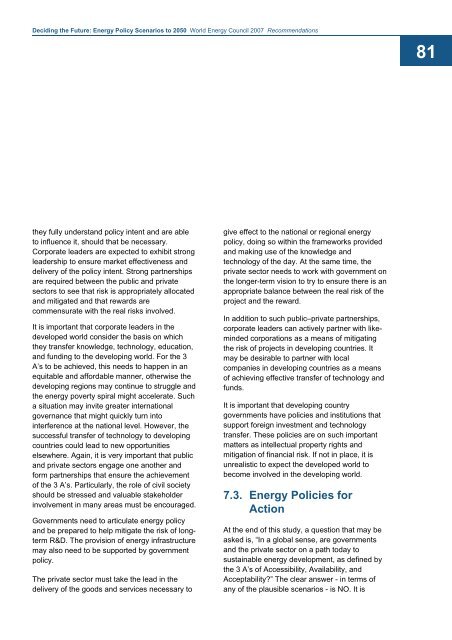Deciding the Future: Energy Policy Scenarios to 2050
Deciding the Future: Energy Policy Scenarios to 2050
Deciding the Future: Energy Policy Scenarios to 2050
You also want an ePaper? Increase the reach of your titles
YUMPU automatically turns print PDFs into web optimized ePapers that Google loves.
<strong>Deciding</strong> <strong>the</strong> <strong>Future</strong>: <strong>Energy</strong> <strong>Policy</strong> <strong>Scenarios</strong> <strong>to</strong> <strong>2050</strong> World <strong>Energy</strong> Council 2007 Recommendations<br />
81<br />
<strong>the</strong>y fully understand policy intent and are able<br />
<strong>to</strong> influence it, should that be necessary.<br />
Corporate leaders are expected <strong>to</strong> exhibit strong<br />
leadership <strong>to</strong> ensure market effectiveness and<br />
delivery of <strong>the</strong> policy intent. Strong partnerships<br />
are required between <strong>the</strong> public and private<br />
sec<strong>to</strong>rs <strong>to</strong> see that risk is appropriately allocated<br />
and mitigated and that rewards are<br />
commensurate with <strong>the</strong> real risks involved.<br />
It is important that corporate leaders in <strong>the</strong><br />
developed world consider <strong>the</strong> basis on which<br />
<strong>the</strong>y transfer knowledge, technology, education,<br />
and funding <strong>to</strong> <strong>the</strong> developing world. For <strong>the</strong> 3<br />
A’s <strong>to</strong> be achieved, this needs <strong>to</strong> happen in an<br />
equitable and affordable manner, o<strong>the</strong>rwise <strong>the</strong><br />
developing regions may continue <strong>to</strong> struggle and<br />
<strong>the</strong> energy poverty spiral might accelerate. Such<br />
a situation may invite greater international<br />
governance that might quickly turn in<strong>to</strong><br />
interference at <strong>the</strong> national level. However, <strong>the</strong><br />
successful transfer of technology <strong>to</strong> developing<br />
countries could lead <strong>to</strong> new opportunities<br />
elsewhere. Again, it is very important that public<br />
and private sec<strong>to</strong>rs engage one ano<strong>the</strong>r and<br />
form partnerships that ensure <strong>the</strong> achievement<br />
of <strong>the</strong> 3 A’s. Particularly, <strong>the</strong> role of civil society<br />
should be stressed and valuable stakeholder<br />
involvement in many areas must be encouraged.<br />
Governments need <strong>to</strong> articulate energy policy<br />
and be prepared <strong>to</strong> help mitigate <strong>the</strong> risk of longterm<br />
R&D. The provision of energy infrastructure<br />
may also need <strong>to</strong> be supported by government<br />
policy.<br />
The private sec<strong>to</strong>r must take <strong>the</strong> lead in <strong>the</strong><br />
delivery of <strong>the</strong> goods and services necessary <strong>to</strong><br />
give effect <strong>to</strong> <strong>the</strong> national or regional energy<br />
policy, doing so within <strong>the</strong> frameworks provided<br />
and making use of <strong>the</strong> knowledge and<br />
technology of <strong>the</strong> day. At <strong>the</strong> same time, <strong>the</strong><br />
private sec<strong>to</strong>r needs <strong>to</strong> work with government on<br />
<strong>the</strong> longer-term vision <strong>to</strong> try <strong>to</strong> ensure <strong>the</strong>re is an<br />
appropriate balance between <strong>the</strong> real risk of <strong>the</strong><br />
project and <strong>the</strong> reward.<br />
In addition <strong>to</strong> such public–private partnerships,<br />
corporate leaders can actively partner with likeminded<br />
corporations as a means of mitigating<br />
<strong>the</strong> risk of projects in developing countries. It<br />
may be desirable <strong>to</strong> partner with local<br />
companies in developing countries as a means<br />
of achieving effective transfer of technology and<br />
funds.<br />
It is important that developing country<br />
governments have policies and institutions that<br />
support foreign investment and technology<br />
transfer. These policies are on such important<br />
matters as intellectual property rights and<br />
mitigation of financial risk. If not in place, it is<br />
unrealistic <strong>to</strong> expect <strong>the</strong> developed world <strong>to</strong><br />
become involved in <strong>the</strong> developing world.<br />
7.3. <strong>Energy</strong> Policies for<br />
Action<br />
At <strong>the</strong> end of this study, a question that may be<br />
asked is, “In a global sense, are governments<br />
and <strong>the</strong> private sec<strong>to</strong>r on a path <strong>to</strong>day <strong>to</strong><br />
sustainable energy development, as defined by<br />
<strong>the</strong> 3 A’s of Accessibility, Availability, and<br />
Acceptability?” The clear answer - in terms of<br />
any of <strong>the</strong> plausible scenarios - is NO. It is

















